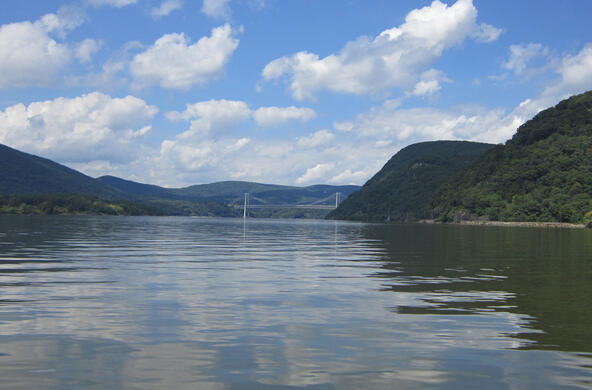Cary Institute, NYSDEC, Marist, USGS and partners join forces to protect river.
Poughkeepsie, New York—A new high-tech environmental monitoring station based at Marist College in Poughkeepsie was unveiled today on the banks of the Hudson River.
The new station will continuously monitor water quality and automatically collect samples for the assessment of toxics and pharmaceuticals. It is part of a network of 15 monitoring stations called the Hudson River Environmental Conditions Observing System (HRECOS) that provide round-the-clock data on conditions in the Hudson River, from Albany to the New York Harbor. These stations include a mobile station on the Clearwater Sloop.

Every 15 minutes data on a range of variables— such as temperature, salinity, and pH – are collected by the monitoring stations. By keeping a pulse on the health of the Hudson River, HRECOS informs flood risk, pollution cleanup, DEC permitting, restoration efforts, and fisheries management.
The Poughkeepsie station was built in partnership with the U.S. Geological Survey (USGS), the New York State Department of Conservation (NYS DEC), the Cary Institute or Ecosystem Studies, and Marist College. Funding for the new station was made possible through the Environmental Protection Agency.
Effective immediately, the USGS will begin using the station to monitor sediment, nutrient, and pesticide conditions in the Hudson River. The NYS DEC will also be relying on data from the station in their assessments of the state’s water quality.
“The HRECOS partnership has helped make the Hudson River one of the most understood rivers in the world,” said NYS DEC Hudson River Estuary Coordinator Fran Dunwell, who spoke at the unveiling. “Data it provides are essential to tracking the river’s recovery and ensuring current management practices preserve and protect the Hudson, now and for future generations.”
Stuart E.G. Findlay, an aquatic ecologist at the Cary Institute and a HRECOS partner described the capabilities of the new station. “By allowing remote sampling, the new station allows unprecedented access to the river,” said Findlay. “We can track how extreme weather influences wastewater discharge, the presence of pharmaceutical pollution, and toxins that adhere to sediments.”
“Marist is excited to be a partner in the HRECOS effort to understand the Hudson River,” said Marist College Executive Vice President Geoffrey L. Brackett, about the college’s partnership in the project. “Technology used will be infused in our course offerings that strive to train tomorrow’s scientists and resource managers.”
On Saturday, July 21st the public can learn more about HRECOS during an interactive River Day activity. For more information, visit www.hudsonriverdayny.org.
HRECOS partners include: The Cary Institute of Ecosystem Studies, Clearwater, Hudson River Foundation, Hudson River National Estuarine Research Reserve, Lamont Doherty Earth Observatory of Columbia University, NYS DEC Hudson River Estuary Program and Division of Water, Stevens Institute, and The U.S. Geological Survey. Learn more at www.hrecos.org.
The Cary Institute of Ecosystem Studies is a private, not-for-profit environmental research and education organization in Millbrook, N.Y. For more than twenty-five years, Cary Institute scientists have been investigating the complex interactions that govern the natural world. Their objective findings lead to more effective policy decisions and increased environmental literacy. Focal areas include air and water pollution, climate change, invasive species, and the ecological dimensions of infectious disease.






